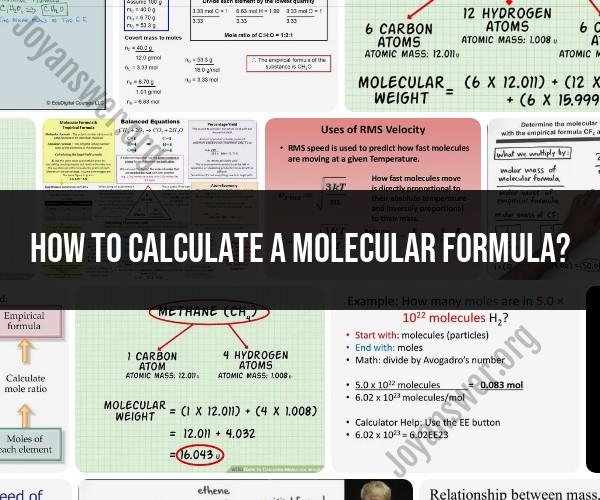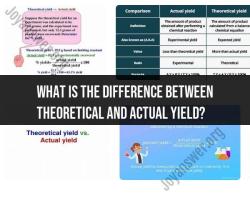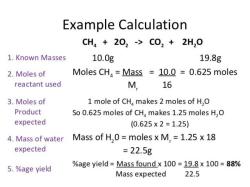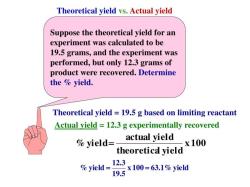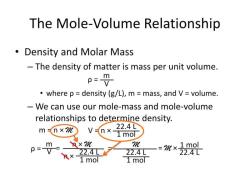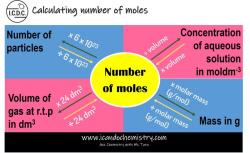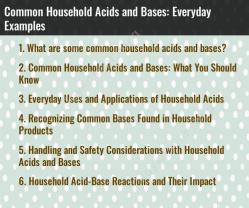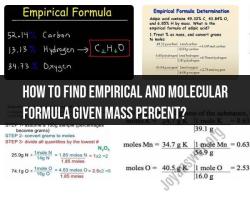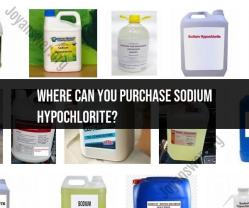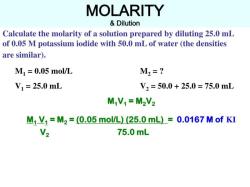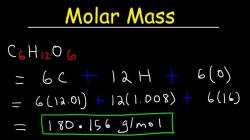How to calculate a molecular formula?
Calculating the molecular formula of a compound requires knowledge of its empirical formula, the molar mass, and the relationship between the two. Here's a step-by-step guide on how to calculate a molecular formula:
Step 1: Determine the Empirical Formula
- Start with the empirical formula, which represents the simplest whole-number ratio of the elements in the compound. You can determine the empirical formula through elemental analysis or by analyzing mass ratios.
Step 2: Calculate the Molar Mass of the Empirical Formula2. Calculate the molar mass of the empirical formula by summing the atomic masses of all the elements in it. You can find the atomic masses on the periodic table.
Step 3: Collect Additional Data3. Collect additional data, such as the compound's molar mass determined from experimental data (e.g., mass spectrometry), spectroscopic data (e.g., infrared spectroscopy or nuclear magnetic resonance), or other relevant information.
Step 4: Determine the Ratio4. Compare the molar mass of the empirical formula (from step 2) with the molar mass determined from experimental data (from step 3). If the two molar masses are the same, the empirical formula is also the molecular formula.
Step 5: Calculate the Ratio5. If the molar masses are different, determine the ratio between the molar mass of the compound (from step 3) and the molar mass of the empirical formula (from step 2).
Step 6: Adjust the Subscripts6. Adjust the subscripts in the empirical formula to match the ratio calculated in step 5. These adjusted subscripts represent the correct whole-number ratio of atoms in the molecular formula.
Step 7: Determine the Molecular Formula7. The adjusted empirical formula from step 6 is now the molecular formula.
Here's a simplified example:
Empirical Formula: CH2 (for a compound with 1 carbon atom and 2 hydrogen atoms).
Experimental Data: The compound's molar mass determined from experimental data is 30 g/mol.
Molar Mass of Empirical Formula: CH2 = (1 × 12.01 g/mol) + (2 × 1.01 g/mol) = 14.03 g/mol
Ratio: 30 g/mol (experimental molar mass) / 14.03 g/mol (molar mass of empirical formula) ≈ 2.14
Adjust the Ratio: Round the ratio to the nearest whole number. In this case, the ratio is approximately 2.14, so you can round it to 2.
Determine the Molecular Formula: The adjusted empirical formula is C2H4. So, the molecular formula is C2H4, which represents ethylene.
This process allows you to determine the correct molecular formula based on experimental data and the empirical formula. It's important to note that the molecular formula represents the actual number of atoms of each element in a compound, while the empirical formula represents the simplest whole-number ratio of atoms.
Demystifying Molecular Formulas: How to Calculate Them
A molecular formula is a chemical formula that shows the number of atoms of each element in a molecule. It is important to be able to calculate molecular formulas in order to understand the structure and properties of compounds.
There are a number of ways to calculate molecular formulas. The most common method is to use the empirical formula of the compound. The empirical formula is the simplest whole-number ratio of atoms in a compound.
To calculate the molecular formula from the empirical formula, you need to know the molar mass of the compound. The molar mass is the mass of one mole of a substance. It is expressed in grams per mole (g/mol).
Once you know the molar mass and empirical formula of the compound, you can use the following formula to calculate the molecular formula:
Molecular formula = Empirical formula * n
where:
- n is the number of empirical units in the molecular unit.
To calculate the value of n, you can divide the molar mass of the compound by the molar mass of the empirical formula.
Step-by-Step Guide to Calculating Molecular Formulas
Here is a step-by-step guide to calculating molecular formulas:
- Determine the empirical formula of the compound. This can be done by elemental analysis, which involves determining the mass percentage of each element in the compound.
- Calculate the molar mass of the empirical formula. This can be done by adding up the atomic masses of all of the elements in the empirical formula, multiplied by their respective stoichiometric coefficients.
- Calculate the molar mass of the compound. This can be done experimentally, or it can be estimated using the empirical formula and the known molar masses of the elements in the compound.
- Calculate the value of n by dividing the molar mass of the compound by the molar mass of the empirical formula.
- Multiply the empirical formula by n to get the molecular formula.
The Art and Science of Determining Molecular Structures
Determining the molecular structure of a compound is a more complex task than calculating its molecular formula. However, knowing the molecular formula of a compound can be a helpful starting point for determining its molecular structure.
There are a number of techniques that can be used to determine the molecular structure of a compound. Some of the most common techniques include:
- NMR spectroscopy: NMR spectroscopy can be used to determine the type and number of atoms in a molecule, as well as their bonding relationships.
- Mass spectrometry: Mass spectrometry can be used to determine the molecular weight of a compound and to identify the fragments that are produced when the compound is broken apart.
- Infrared (IR) spectroscopy: IR spectroscopy can be used to identify the functional groups that are present in a molecule.
By using these and other techniques, chemists can determine the molecular structure of a wide range of compounds. This information is essential for understanding the properties of compounds and for developing new materials and technologies.
Conclusion
Calculating molecular formulas is a fundamental skill in chemistry. It is a relatively simple task, but it requires knowing the empirical formula and molar mass of the compound. By following the steps outlined above, you can easily calculate the molecular formula of any compound.
